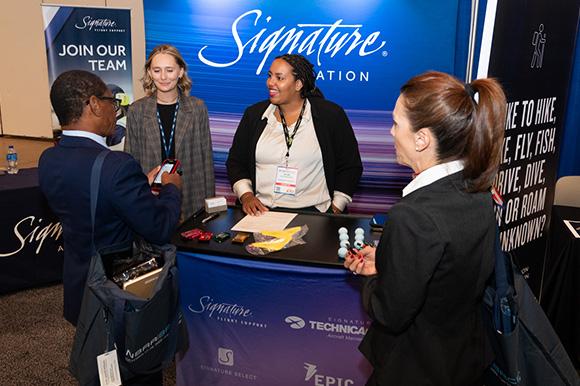NBAA-BACE To Host Job Fair Amid Industry Measures To Meet Challenges

LAS VEGAS—For the first time, the National Business Aviation Association is hosting a career fair at this year’s NBAA-BACE here, as the shortage of workforce professionals is projected to reach historic levels, it notes.
The industry is aging and a need for young professionals, pilots and those in maintenance, manufacturing, engineering and other specialties has escalated.
NBAA’s inaugural job fair is an example of the creative approach the business aviation industry is taking to try to alleviate the workforce issues. It is a multipronged effort. For their part, manufacturers are increasing pay and benefits and other perks in an effort to recruit and retain workers.
The numbers are large.
Training provider CAE, in its 2023 Aviation Talent Forecast, projects demand over the next 10 years for 1.3 million civil aviation professionals, NBAA says.
Boeing’s latest forecast projects global demand for 649,000 pilots over the next 20 years along with 690,000 maintenance technicians and 938,000 cabin crewmembers. That does not even count demand from business aviation. Over the next 10 years, more than 30% of U.S. aviation technicians and more than 25% of commercial pilots will be at or near retirement, Boeing predicts.
Textron Aviation in Wichita and Piper Aircraft, based in Vero Beach, Florida, have each added on-site health care centers, offering no-cost medical services.
Textron Aviation has added on-site cafes across its campuses and begun construction of an expansive one-stop hiring and learning center for skill development and training.
“We are always striving to go from good to great in our culture,” says Ron Draper, Textron Aviation president and CEO. It is on track to hire 2,000 employees this year to allow for growth and attrition.
Over the summer months, it took on a record 350 college and 150 high school interns who worked with mentors and were assigned to a cross-section of business functions.
“This summer, we had over 500 young people running around campus in Wichita,” Draper says. “That was very exciting to see the energy and the ideas that they brought. And those are future employees for us.”
Staffing challenges have been most acute over the past 24-36 months, Todd Simmons, Cirrus Aircraft president of customer service, said in July. Cirrus employs more than 2,500 people.
“We know there have been compensation changes [in the industry], and Cirrus has made those changes,” Simmons says, in everything from direct labor to its pilots. It has enhanced employee benefits, such as health care and 401(K) plans. And it has been inventive in adding a variety of options for pilots and the experiences they may have within the company.
“That’s not to say there are not pilots that are trying to build toward an airline career,” he says. “There are and there always will be.” Cirrus, however, now offers a variety of pilot pathways. Pilots have become product specialists, production flight-test and experimental flight-test pilots and leaders in sales and marketing. The company has been investing in training and is spending more time in the recruitment process.
As a result, “we are beginning to see more stability in the employee population, especially in the past six months, because of that,” Simmons says.
Like others, Piper Aircraft is competing for top-quality employees. That’s one reason it added the on-site family health center to its campus in a partnership with Marathon Health.
While workforce shortages, along with supply chain challenges, present a challenge to aircraft production, they can also present advantages, says Ron Gunnarson, Piper Aircraft vice president of sales, marketing and customer support.
“We are an industry that follows the market like no other industry with the ups and downs,” Gunnarson says.
When times are good, the industry has a tendency to overproduce aircraft.
“You are going full tilt, full throttle all the time, and you get yourself out on a ledge,” he says. “No one can overbuild like general aviation OEMs.”
That can present difficulties in times of a downturn.
Today’s supply chain and labor shortages are “keeping us in the real world,” Gunnarson says, with a healthy order backlog.
“It’s a very good and special place to be,” he says.
NBAA’s job fair is open to anyone attending NBAA-BACE who is searching for a new job or career in business aviation. The job fair began Oct. 18 and will continue on Oct 19 from 9 a.m. to 3 p.m. So far, 16 exhibitors have signed up to host recruiting stations for the event and will have recruiters available.





